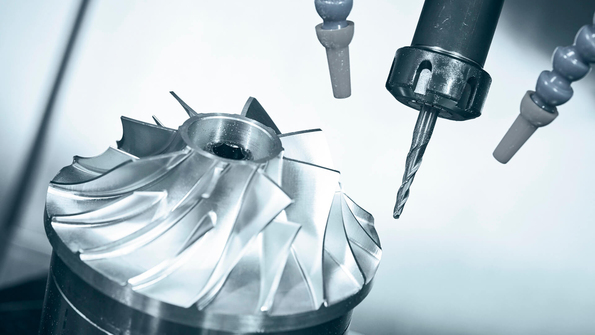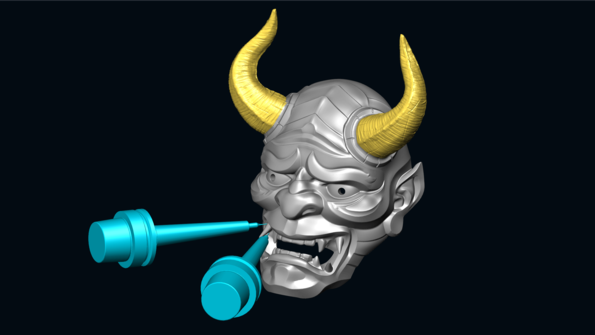5-axis milling
Quickly, easily and safely manufacture 3D surfaces
5-axis simultaneous milling quickly and efficiently produces high-quality surfaces unlike any other milling method. Tebis CAM software lets you tap into the full potential of your valuable high-performance machines: Collision-free programs can be easily configured and calculated for all multi-axis machining operations. Homogeneous toolpaths with low tool wear and checked for tilt direction are automatically generated.
White paper
Multi-sided machining with positional axis? Or do you prefer 5-axis simultaneous machining?
Whether a part should be milled using a 5-axis simultaneous methods or positional methods, depends on the specific machining task, the complexity of the part and the machine kinematics.
Are you still wondering whether machines for 5-axis simultaneous machining are worthwhile for you? Or are you already using multi-axis machines and believe you can get even more out of them? If so, you’re not alone: According to a survey, 62 percent of those with multi-axis machines don’t believe they’re exploiting the full potential of their machines.
We compared the advantages and disadvantages. Read our white paper.
Highly flexible: Targeted control of machine and tool movements
One of Tebis's special strengths is that it lets you specifically control machine and tool movements depending on the machine type, component geometry and machining task. For example, you can clamp individual axes, use lead angles, define vectors or use other guide elements.
Your benefits:
- Homogeneous machine movements
- Optimal cutting conditions
- Higher surface quality
- Shorter machining time
- Longer tool life
The options for optimizing machine movements are integrated in your 5-axis simultaneous milling – with no additional modules required.
Control pivot and rotation axis
Movements of the pivot and rotation axis can be controlled with no extra design effort. For example, an axis can be completely clamped and the movement of the second axis can be interpolated between two angles. Movement can be interpolated in the milling direction or in the path direction.
Control tool direction with guide elements or lead angles
You can systematically control the tool direction with guide elements in 5-axis simultaneous surface finishing. Movement is interpolated between the stepover direction and the guide element or between the milling direction and the guide element based on your inputs. In the first case, the tool direction remains constant in the milling direction, and in the second case it remains constant in the stepover direction. As an alternative, you can also interpolate in both directions.
A lead angle can also be defined in all strategies. A tool with a lead angle always moves in the cutting direction of the toolpath: An upward cut and optimal cutting conditions are guaranteed.
Milling between vectors
Defined vectors on the part will determine the movement of your tool which can be optimized during programming. You can optimize tool movement during programming: You can verify the tilt direction with the integrated preview functionality and adjust it interactively.
5-axis simultaneous machining created automatically from 3+2-axis machining
In 5-axis simultaneous avoidance milling, programs for simultaneous 5-axis milling with optimal axial positions are generated automatically from 3+2-axis NC programs with fixed positional axis.
Collisions are detected and automatically avoided using 5-axis simultaneous movements, utilizing the full machine kinematics and the precise geometry of the machine head.
This allows the utilization of short tools to provide outstanding machining results of electrodes and parts with deep cavities.
Even less-experienced users can generate complex collision-free CAM programs with just a few mouse-clicks.
In 5-axis simultaneous avoidance milling, potential collisions with the machine head are automatically prevented.
Simultaneous 5-axis functions for special manufacturing tasks
NC programming of milling paths for simultaneous 5-axis milling is easy to learn in Tebis. Tebis programmers who’ve previously generated 3-axis toolpaths can learn very quickly how to work with 5-axis milling programs.
Tebis provides multiple functions for programming toolpaths for simultaneous 5-axis milling. Each function is tailored for special machining tasks and only contains the parameters that are needed for that operation.
- Milling curves: Face and side milling curves
- Multi-axis engraving
- Roughing contours: 5-axis side milling roughing of planar and constant-curvature flank surfaces
- Finishing contours: 5-axis side milling finishing of planar and constant-curvature flank surfaces
- Roughing surfaces: Adaptive or contour-parallel roughing of free-form surfaces
- Finishing surfaces: HSC milling with any tool type
- Face milling surfaces: HSC face milling of simple and complex free-form surfaces with a lead angle
- Side milling surfaces: 5-axis milling of complex free-form surfaces
- Roughing pockets: Adaptive or contour-parallel roughing of free-form pockets
- Radial roughing: Roughing of rotational components
- Multi-axis deburring


















